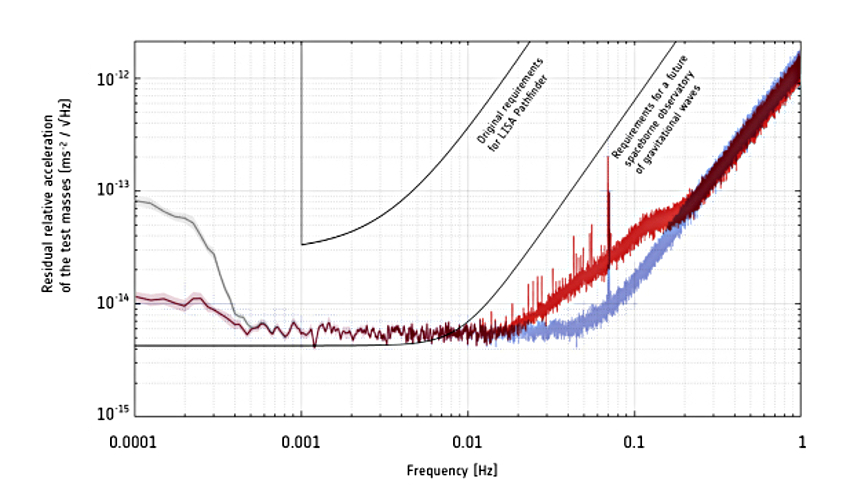
 Credit: ESA/LISA Pathfinder Collaboration
Credit: ESA/LISA Pathfinder Collaboration
Free Fallin'
According to Einstein, the acceleration of masses generates gravitational radiation, ripples that propagate through the fabric of spacetime. The report of the detection of gravitational radiation by LIGO, the Laser Interferometer Gravitational-Wave Observatory, opened an entirely new window on the Universe, allowing us to observe phenomena (like the merging of massive black holes) which may not be observable by any other means. This triumphant detection by LIGO also showed that the severe technical challenges required to detect gravitational radiation (which requires measurement of changes in length smaller than one-ten-thousandth the diameter of a proton) could be met. But there are limits to the types of gravitational radiation that ground-based observatories like LIGO can measure because of limitations on the lengths of the detector arms, and terrestrial background noise. To move beyond these limitations requires a gravitational wave observatory in space. A space-based gravitational wave observatory called the Evolved Laser Interferometer Space Antenna, or eLISA, is currently under development. eLISA consists of one "Mother" and two "Daughter" spacecraft orbiting the Sun in a nearly perfect equilateral triangle a million kilometers on a side. eLISA will detect gravitational radiation by measuring tiny changes in the separation between test masses housed in the three spacecraft. These test masses must be kept isolated from all electromagnetic forces, and be kept almost perfectly weightless. To demonstrate that this incredibly difficult technical feat is possible, LISA Pathfinder was launched on December 3, 2015. LISA Pathfinder is a spacecraft containing two test masses kept in a nearly perfectly controlled gravitational free-fall. After a six month checkout, the first spectacular results from LISA Pathfinder have been obtained. The graph above shows the residual relative acceleration on the test masses. Incredibly tiny disturbances (like residual gas molecules in the near-vacuum of the test-mass chamber bouncing off the test masses) were measured and corrected. The blue curve shows the remaining residual accelerations on the test masses after all known corrections have been applied. The black curves show the requirements for eLISA compared to the performance of LISA Pathfinder. At frequencies higher than 0.01 Hz, the residual test mass accelerations measured by LISA Pathfinder were five times smaller than the eLISA requirements. This points the way to an eventual deployment of eLISA, further opening the spectrum of gravitational radiation which can be measured, and the types of mysterious, otherwise undetectable phenomena that can be observed.
Published: June 13, 2016
<
HEA Dictionary ● Archive
● Search HEAPOW
● Other Languages
● HEAPOW on Facebook
● Download all Images
● Education ● HEAD
>

Each week the HEASARC
brings you new, exciting and beautiful images from X-ray and Gamma ray
astronomy. Check back each week and be sure to check out the HEAPOW archive!
Page Author: Dr. Michael F. Corcoran
Last modified Tuesday, 27-Feb-2024 10:13:28 EST


